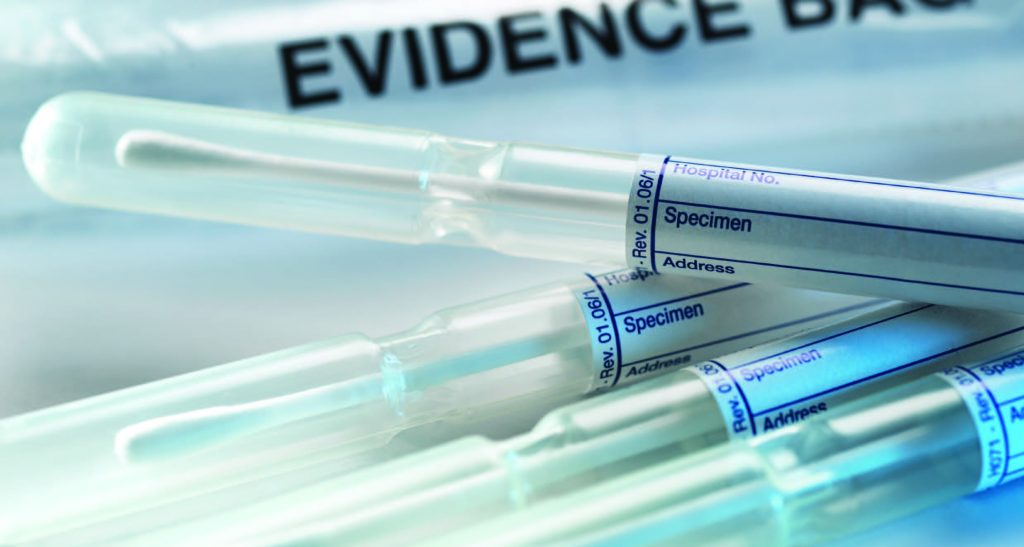 The National Sexual Assault Kit Initiative (SAKI) supports state and local jurisdictions as they develop effective approaches to sexual assault cases.
The National Sexual Assault Kit Initiative (SAKI) supports state and local jurisdictions as they develop effective approaches to sexual assault cases.
The Bureau of Justice Assistance administers the SAKI program, which aims to ensure just resolution to sexual assault cases through
■ a comprehensive and victim-centered approach,
■ investigation and prosecution of cases associated with previously unsubmitted sexual assault kits (SAKs), and
■ jurisdictional capacity building to prevent unsubmitted SAKs in the future.
As of March 2019, 54 sites used SAKI funding to inventory more than 70,000 previously unsubmitted SAKs. Several factors have led to the current backlog of unsubmitted SAKs, including poor evidence tracking, ineffective investigation practices, inadequate resources, poor understanding of crime laboratory policies, and limited understanding among law enforcement personnel about the value of testing SAKs. Addressing these issues is crucial for improving public safety and supporting survivors of sexual assault.
Through the SAKI Training and Technical Assistance (TTA) program, led by RTI International and in partnership with the International Association of Chiefs of Police and other subject matter experts, SAKI sites can establish data-driven, sustainable practices.
Additionally, the SAKI TTA team has assembled a comprehensive collection of training and resources that are available to the law enforcement community, criminal justice partners, and the public. The following sections highlight the publicly available resources on www.sakitta.org.
SAKI Virtual Academy
Learners can choose from five e-learning curricula that provide guidance about issues related to unsubmitted SAKs. The courses cover SAK testing, the effects of trauma, victim notification, and cold case investigation and prosecution.
SAKI Toolkit
Multidisciplinary team members are encouraged to explore the SAKI Toolkit for resources aimed at improving their community’s response to sexual assault. The SAKI Toolkit covers the key categories—evidence tracking, investigation, forensics, and engaging victims. Individuals can explore resources and save tools to customizable “briefcases” to share with others.
SAKI Webinars
Presentations feature experts with years of experience in sexual assault. The following are two examples of archived webinars.
Law Enforcement and Victim Advocates: Supporting Survivors Together
When victim advocates and law enforcement work together, survivors have a better understanding of the judicial system process and their rights. This webinar focuses on practitioners in each discipline using their expertise and trauma-informed approaches to overcome barriers and promote productive teamwork to support survivors.
Understanding Case Connectivity—How Testing SAKs Can Link Criminal Cases
This webinar explains how case connectivity can be established through SAK testing. The webinar also provides step-by-step guidance for organizing and analyzing the data needed to establish case connectivity.
SAKI Research in Action
SAKI encourages jurisdictions to engage in research related to sexual assault response reform. The research findings can directly inform what law enforcement knows about sexual assault and how agencies respond to it. The following are frequently asked questions about unsubmitted SAKs.
Should policies be focused on “stranger rapists”?
Through a review of data from serial sex offenders linked via DNA testing of SAKs, researchers found that serial sex offenders do not appear to consistently select a certain “type” of victim or even maintain a certain offending pattern. Rather, the driving factor is an opportunity to offend; therefore, a serial rapist will target strangers, acquaintances, and vulnerable individuals. Research from SAKI demonstrates that more than one-quarter of the serial offenders sexually assaulted both strangers and non-strangers.
Why should jurisdictions submit and test all their SAKs?
Researchers in Detroit found that 40 percent of SAKs from sexual assaults with non-stranger perpetrators yielded a Combined DNA Index System (CODIS)-eligible DNA profile, compared to 54 percent of SAKs associated with stranger-perpetrated sexual assaults. Additionally, researchers found that CODIS entry rates and CODIS hit rates between stranger and non-stranger SAKs were equivalent. These results emphasize the importance of testing all SAKs.
How can testing SAKs potentially link criminal cases together?
In the context of sexual assault, case connectivity means establishing that the person who committed a sexual assault can be linked to additional crimes. These crimes may be other sexual assaults—ranging from lower-level offenses (e.g., exhibitionism or voyeurism) to higher-level offenses (e.g., rape)—or they may be nonsexual crimes (e.g., robbery, drug offenses, burglary, or homicide).
Example: In June 2018, the Dallas County District Attorney’s Office SAKI team announced they had arrested George Guo for the murder of Dr. Katherine Bascone. Dr. Bascone was sexually assaulted and strangled on June 19, 1988, in Highland Park, Texas; the attack caused an anoxic brain injury. In February 2018, Dr. Bascone succumbed to her injuries. A medical examiner in Tulsa, Oklahoma, ruled Dr. Bascone’s death a homicide. Guo has been linked to at least three other sexual assaults or attempted assaults on young women.
Multidisciplinary response to cold case sexual assaults can present many challenges, such as completing inventories and testing plans for SAKs, reopening investigations, reengaging survivors of sexual assault, evaluating evidence, and bringing cases a just resolution. SAKI provides wide-ranging support to SAKI sites and multidisciplinary teams engaged in comprehensive sexual assault response reform that stems from evidence found in previously unsubmitted SAKs.🛡


